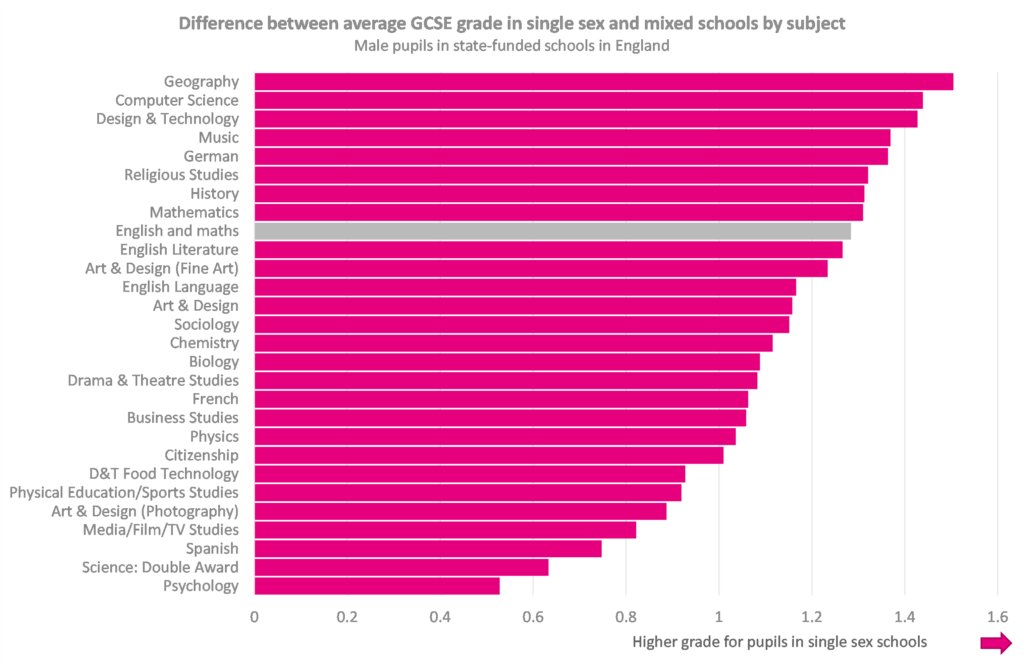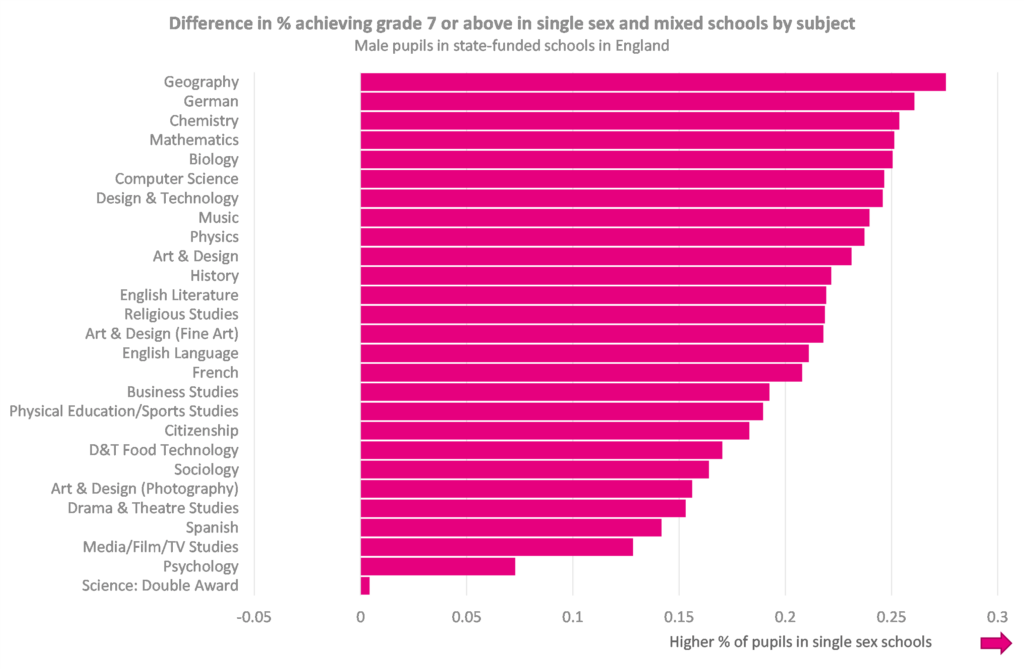A few months ago, I wrote a post showing that – once you control for prior attainment and other differences – girls in single sex schools aren’t that much more likely to choose A-Level physics than girls in mixed schools.
But there’s one point I might have overlooked. Do girls in single sex schools do particularly well in GCSE physics, relative to other subjects? If so, it might be that single sex schooling makes more of a difference in progression to A-Level physics than I’d concluded in my earlier piece.
And, setting aside the point about A-Level physics, the question of how performance in single sex and mixed schools compares subject-by-subject is quite an interesting one in its own right.
Could it be the case that girls in girls’ schools do particularly well in ‘gendered’ subjects like physics and computer science? And might the same be true of boys in boys’ schools?
Let’s see what we can find out. I’ll be using data from the National Pupil Database on state-funded schools are England. We’ll focus on pupils who completed Year 11 in a state-funded school in England in 2022.
Attainment at KS4 by subject
We’ll start with a look at the size of the attainment gap between pupils in single sex schools and their peers. This is fairly large, especially for boys.

But, as I noted in my last piece, we may not be able to put much of this difference down to the single sex environment, as there are a lot of other differences between single sex and mixed schools.
Let’s get down to subject level. The chart below shows how the difference in average grade between girls in girls’ and mixed schools varies by GCSE subject. The difference in average grade in English and maths is shown in grey for context.

Girls in single sex schools achieve higher grades, on average, in every subject shown. The difference in average English and maths grade is just over a grade.
The chart doesn’t provide striking evidence of the idea that pupils in girls’ schools do particularly well in gendered subjects. Some of the subjects with relatively large gaps include computer science, maths and design and technology, all of which are less popular with female than male students at A-Level and beyond.
On the other hand, pupils in girls’ schools also do relatively well in subjects such as geography and history, which don’t tend to have large gender gaps in progression.
Let’s take a look at the differences between boys in boys’ schools and boys in mixed schools.

Again, boys in single sex schools have higher average grades across all of the subjects shown. The difference in average English and maths grade is slightly higher than for girls, at just under 1.3 grades.
If it were the case that boys in boys’ schools do particularly well in subjects that tend to be more popular with female students, we’d expect to see large gaps in subjects like English, art, religious studies and modern foreign languages. And we do see this to some extent, but we also see large differences in some subjects that don’t tend to have gender gaps in progression, like geography and history, as well as in computer science and maths, both of which tend to be relatively popular with male students at A-Level and beyond.
A look at top grades
We’ve looked at differences in average grade. Now let’s compare the proportions achieving top grades in mixed and single sex schools. This might be more relevant than average grade in determining whether a pupil is likely to go on to study the subject at A-Level.
The chart below shows the difference in the proportions achieving a grade 7 or above by GCSE subject.

Differences are particularly high in the single science subjects. Well over half (67%) of female entrants from single sex schools achieved a grade 7 or higher in GCSE physics, compared to 43% from mixed schools. In biology, the figures are 71% in single sex schools compared to 48% in mixed, and in chemistry 67% in single sex compared to 45% in mixed. The proportions are far lower in computer science, which tends to be particularly severely graded: 55% in single and 32% in mixed.
Again, this doesn’t really support the theory that girls in single sex schools do particularly well in subjects that tend to be more popular with male students. While physics, chemistry and computer science do tend to be more popular with male students, other subjects in which there are particularly large differences – such as biology and geography – do not.
Let’s see how boys in mixed and single sex schools compare.

Unlike with girls, STEM subjects do not top the list, and physics and computer science in particular are further down. There is a large difference in German, although this is not the case for other modern foreign languages.
All in all, it doesn’t look as though boys in single sex schools are particularly likely to achieve top grades in subjects that tend to be more popular with female students.
Summing up
I didn’t find overwhelming evidence to support the idea that those in single sex schools do particularly well in ‘gendered’ subjects that tend to be more popular with the opposite sex. Certainly not when it comes to boys in single sex schools.
But there is some evidence that girls in single sex schools are particularly likely to get top grades in single science GCSEs compared to their peers in mixed schools.
Want to stay up-to-date with the latest research from FFT Education Datalab? Sign up to Datalab’s mailing list to get notifications about new blogposts, or to receive the team’s half-termly newsletter.







60 Years ago I was the first girl in the history of my mixed grammar school to do Physics and Maths at A level. I failed Physics and scraped a pass in maths – largely as a result of the awful sexism displayed by the boys in the class. In my 30s I trained to become a Maths teacher and on one occasion was faced with shocking sexism from one of the boys. I have often thought that I might have done better to go to the local girls only grammar instead of the mixed grammar.